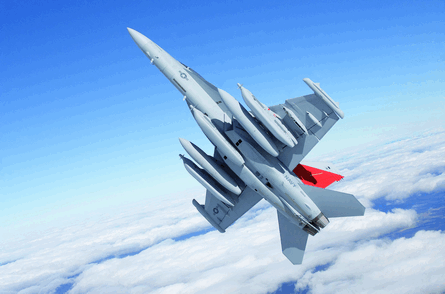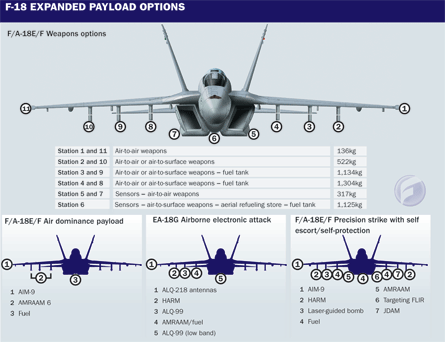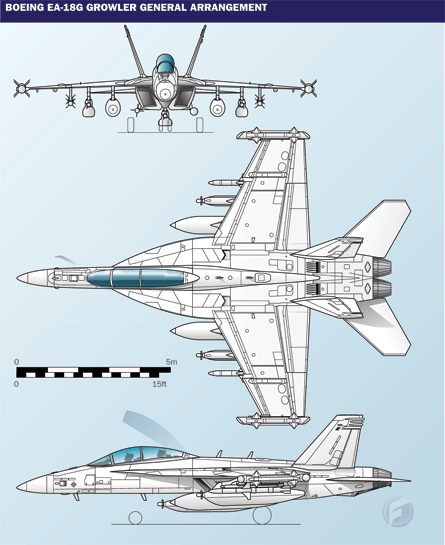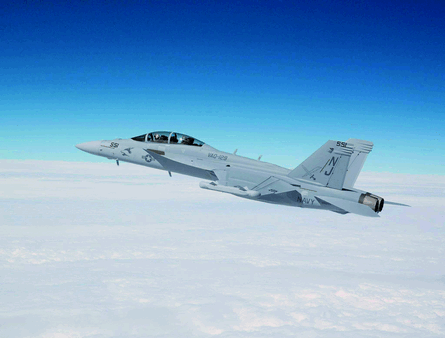If the battlefield were an American football field, the US Navy's venerable but well-worn Northrop Grumman EA-6B Prowler might be thought of as an offensive lineman clearing the path for a running back carrying the ball.
In this case, the Prowler's goal would be the suppression of enemy air defences (SEAD) from a stand-off position using on-board electronic jammers to disrupt radar and communications, clearing the way for the navy, marines or air force strike forces to do their jobs. The Prowler generally carries two AGM-88 high-speed anti-radiation missiles (HARM) to use against radar sites if needed.
 |
|---|
© Boeing |
Given that the navy's fleet of Prowlers is set to be retired in the 2013 timeframe because of airframe life limits, the military has a unique opportunity to grow significantly the role of the "lineman" that will replace the Prowler.
Enhanced Functions
That replacement is the $60 million EA-18G "Growler", a platform with enhanced SEAD capabilities, self-protection and networking abilities that will allow it take on command and control functions as well as SEAD. Using the football analogy, the Growler is poised in the future to become both lineman and quarterback on the navy's playing field.
Operational evaluation of the Growler is to begin shortly, with initial operations capability (IOC) set for September 2009 after the VAQ-132 carrier squadron, the first of 10 navy aircraft carrier squadrons to transition to the Growler, receives its contingent of five aircraft.
So far, prime contractor Boeing Integrated Defense Systems has delivered one aircraft (the fourth production unit) on 3 June to the Fleet Readiness Squadron (VAQ-129) for training, with three earlier production units and two engineering models remaining in the test programme at the Naval Air Warfare Center's Patuxent River, Maryland and China Lake, California sites. Boeing says the first three production aircraft (G1, G2 and G3) may later be delivered to the fleet. The $1.2 billion development programme, started in December 2003, is to conclude in mid- to late next year.
The navy "programme of record" calls for Boeing to deliver 85 Block 1 aircraft with Northrop Grumman-provided airborne electronic attack (AEA) systems up to fiscal year 2013 12 for VAQ-129 and five for each of the 10 carrier squadrons, plus spares. The marines plan to use the existing Prowlers for a longer period, while the air force is investigating the potential for using B-52H bombers with pods for stand-off jamming.
Based on the $54 million Boeing F/A-18F Super Hornet and its twin General Electric F414-GE-400 turbojet engines, the two-seat EA-18G will have a maximum cruise speed of Mach 0.95 (with wing pods attached), up 10% from the Prowler's maximum speed of M0.86.
While carrying the same AGM-88 missiles, ALQ-99 low- and high-band tactical jamming pods and multi-mission advanced tactical terminal (MATT) satellite communications gear as the most advanced Prowler (ICAP-III), the Growler will have the ability to protect itself with two AIM-120C medium-range air-to-air missiles, freeing other aircraft from performing that role. The Growler will carry the ALQ-227(v)1, a new digital version of the EA-6B's USQ-113 communications countermeasures set (CCS) that is better able to locate enemy communication channels and disrupt communications over a wider set of frequencies through the ALQ-99 low-band jammer pod.
 |
|---|
Receiver System
The EA-18G also has a more compact version of the Prowler's ALQ-218 RF receiver system (sensors carried on top of the tail of the Prowler and on the wingtips of the Growler), that when combined with the long baseline interferometer (LBI) antennas located fore and aft of the aircraft, geo-locates radar locations and provides selective reactive jamming capability. The Growler carries the electronics for the ALQ-218(v)2 receiver system in its nose compartment in place of the Super Hornet's M61A1 20mm Vulcan cannon.
All new for the EA-18G is an interference cancellation system (INCANS) that allows the aircraft to maintain UHF communications while jamming, a capability unavailable on the Prowler. The Growler also has the F/A-18's APG-79 active electronically steered array (AESA) radar, allowing for aircrews to track multiple targets simultaneously, as well as the Super Hornet's joint helmet-mounted cueing system (JHMCS), which lets pilots fire missiles simply by looking at a target, and multi-information distribution system (Link 16), which increases battlefield situational awareness.
Mike Gibbons, Boeing EA-18G programme manager, says the pivotal technology on the aircraft is a new software package called the data-correlation mechanism that automatically correlates streams of data generated by all of the Growler's on-board sensors, including the APG-79, ICAP-III receivers and AGM-88E high-speed anti-radiation missile.
Variable Configuration
Although the "normal" carry for the Growler will be three jamming pods, two AIM-120Cs, two AGM-88s and two external fuel tanks that allow the aircraft to carry an extra 2,950kg (6,500lb) of fuel, or more than 9,070kg in total, the aircraft can be configured for as many as five pods or four AGM-88s. A host of other options are available, including clean-wing arrangements that allow the aircraft to fly with no speed restrictions. Power for the ALQ-218, MATT and CCS is provided by the aircraft while the ALQ-99 jammers use ram-air turbines attached to the front of the pods.
In total, the new and improved features appear to be successful in creating, as designed, a command and control holism that will be greater than the sum of the parts. While the results of an early June navy-led multi-force exercise that included four Growlers (two modified Super Hornets and two production aircraft) are classified, Gibbons says officials are "extremely excited" about the outcome. The Growlers were used in ways that there were "no chance" of the EA-6B being used, Gibbons says.
The navy's long-range plans promise more to come. "There are quite a few growth and development items waiting in the queue for study," says Gibbons.
In the near term are plans to replace the MATT due to the "obsolescence of the network it was connected to" in the 2012 timeframe, says Gibbons. In addition to the change in network, Gibbons says the new system, now in a feasibility study phase by the navy, will have increased reliability and require less maintenance. "Back-up batteries have been a real nuisance," he adds.
Also envisaged by the navy in the near future are options to carry the same weaponry as the Super Hornet, including laser-guided bombs. Gibbons says the Growler will be the lead platform for the 2010 test and 2012 fielding of the next generation HARM missile (AARGM), which will have multiple guidance modes to target radar sites that shut down to foil traditional HARM missiles.
Gibbons says the EA-18G will also be the primary platform for the navy's next-generation ALQ-99 jammer, a device that is likely to be fielded in the 2018 timeframe. In addition to carrying the new system, the navy is keen to "extend the mission" of the Growler. Gibbons says studies are under way to look at using the Growler as a "localised command and control vehicle" that would have access not only to next generation jamming pods being flown on other aircraft, but also of unmanned air vehicles and other assets in the force.
 |
|---|
From a human factors standpoint, Boeing planned well in advance for the Growler with just one pilot and one weapons system officer to outperform the Prowler's three electronic counter measures officers (ECMO). The company in 1997 began testing EA-6B pilots and ECMOs in a purpose-built simulator in St Louis, ultimately weighing input from 500 crewmembers when developing early on the EA-18G crew interface software, which allows the crew to share information and tasks.
Crew Training
Crews will learn how to co-ordinate their actions at the navy's fleet readiness squadron (VAQ-129) at NAS Whidbey Island, Washington, using three tactical operational simulators built by Boeing and L-3. The navy plans to offer basic pilot front seat training using the Super Hornet at existing training sites and "difference training" at Whidbey for Growler-specific missions using the seven-screen simulators, the first of which earned its "ready for training" status on 23 June.
The navy is contemplating a fourth simulator to support a Growler roll-out schedule that calls for three more deliveries this year, 11 next year and as many as 22 a year by 2011.
Boeing assembles the wings, forward fuselage and performs the final assembly of all F/A-18s in two plants in St Louis. The rear fuselage is built by Northrop in El Segundo. While the ALQ-99 jamming pods are integrated at the navy's Whidbey Island facility, Boeing installs the ALQ-218 wingtip pods in St Louis, attaching the devices to the same two attach points that hold the AIM-9 Sidewinder air-to-air missiles on the Super Hornet. Total build time for the Grower is 18 months, says Boeing.
Aircraft Funding
The navy to date has funded the first 56 aircraft, although Boeing expects a contract for the remaining 29 aircraft in the programme of record next year. Boeing says a fleet of 85 Growlers leaves a gap for one reserve squadron and three expeditionary squadrons that now use the Prowler and will decommission the aircraft in 2012.
 |
|---|
© Boeing |
At Boeing's St Louis plant, the production process for the Growler is virtually indistinguishable from that of the Super Hornet. Many of the internal changes required to route 1.6km (1 mile) of cabling - including 318 RF cables - connecting various SEAD systems have been retrofitted into the Super Hornet line to maintain commonality. Also in common with the F/A-18F are forward fuel tank pass-through modifications needed to route cabling from the Growler's electronic bays in the nose to its components in the wings and tail.
By 1 May, Boeing had delivered 197 F/A-18Fs and 157 F/A-18Es (single-seat) to 19 navy squadrons and nine aircraft carrier wings. As the Growler and Super Hornet have more than 90% commonality in terms of parts, economy at scale will reduce operational costs.
Like the Super Hornet, Growlers will be covered by Boeing's integrated logistics support for the first year, followed by a Boeing's F/A-18E/F integrated readiness support teaming, a performance-based logistic programme in which the navy pays Boeing to provide a set level of readiness for the Super Hornet fleet. According to Boeing, the navy increased the F/A-18E/F mission capable rate from 57% in 2001 to 73% in 2006 by taking part in the logistic programme.
Externally, there are numerous change that are Growler-unique, some more subtle than others. Most noticeable are changes to outer portions of the Growler's wing, put in place partially because of "the buffet onset at high-g manoeuvres" experienced with Super Hornets, says Boeing.
As part of a Super Hornet transonic flying qualities programme launched before the advent of the Growler, four design changes were developed by engineers at Boeing. When the navy decided to launch the Growler, Boeing offered to include the improvements, in part to minimise motion of the wingtip pods to better locate threats. "We wanted to make the manoeuvres smoother for the [Growler]," says Tony Bargeon, Boeing's EA-18G configuration manager. "We wanted to make the wingtips quieter too."
Leading edge fairings now form a smooth "saw tooth" transition from the outer wing (the outer section that folds up and over for carrier operations) to the inner wing, replacing "snag" edge between the two on the Super Hornet. A 12.5cm (5in)-high by 150cm-long wing fence has been placed on the top surface of each wing about midway along the span, and there are now aileron "tripper strips" just ahead of the aileron hinge line. The two-strip arrangement forms a triangle rough 0.95cm high, eliminating the "aileron buzz" experienced by Super Hornet pilots during the same high-g manoeuvres. Engineers also replaced the perforated hinge fairing between outer and inner wing with a solid hinge fairing to help with the buffeting.
Boeing EA-18G chief engineer Kevin Fogarty says Boeing offered to make the same changes on the Super Hornet production line, but the navy declined.
The RF receiver pods mounted on the wingtips for the ALQ-218 system were designed to maintain the weight, moment of inertia and control feel as the AIM-9 missiles they replace. Engineers originally had placed four fins around the circumference of each pod at the front and back (eight in total) to "improve lift at lower airspeed", says Bargeon, but officials later decided to remove all lower fins after tests showed little value in placing the fins there.
In addition to a new 33cm blade antenna for the communications countermeasures set on the dorsal, the Growler has eight LBI antennas, also known as "bug eyes" at the front and back of the fuselage. One antenna is just ahead of the aircraft's angle-of-attack sensor, causing oscillations in its measurements, an issue engineers solved through software filtering in the flight-control computer. Wingtip pods each contain 28 antenna elements.
Flight Tests
Fogarty says the more than 350 navy flight tests did not uncover any aeromechanical issues with the Growler. "The main objective was to validate that nothing was impacted by the changes," he says. Those changes included not only the SEAD pods, but modified flight-control gains based on the new external configuration with the pods. Boeing first simulated the changes before live testing. Along with the M0.95 speed limit when carrying the with the under-wing pods, Fogarty says there are also roll and pull-up limits.
Problematic from an electronics standpoint were unanticipated temperature changes on the cabling connecting the Growler's ALQ-218 wingtip pods affecting the phase of the signals being sent to the internal electronics in the fuselage. The shifts caused an out-of-tolerance phase condition during testing, affecting system performance, says Fogarty. The solution - duplicating the problem in the laboratory and installing different cable from the same vendor - solved the problem.
As of mid-June, Boeing was testing the final software for the Growler, expecting to be finished by mid- to late July in time for a test readiness review, a necessary hurdle before operational evaluation testing in August.
Also on tap for this summer are the EA-18G's first carrier trials, set to take place on an unnamed carrier at an undisclosed time.
Source: Flight International



















